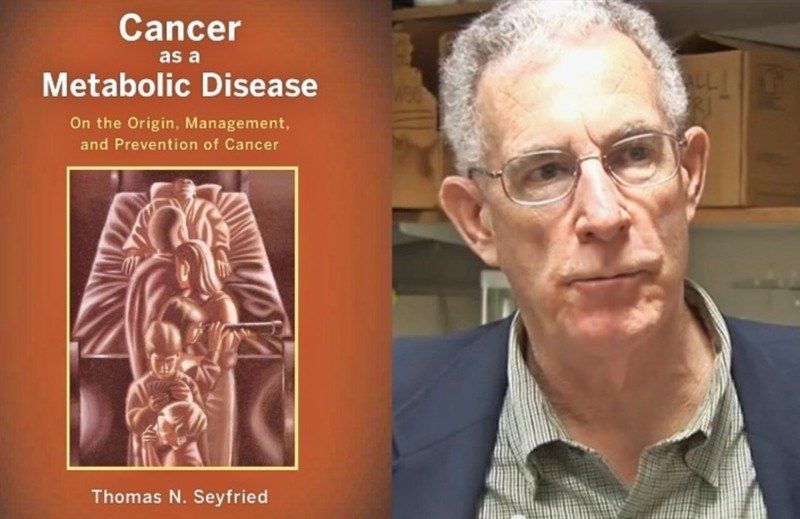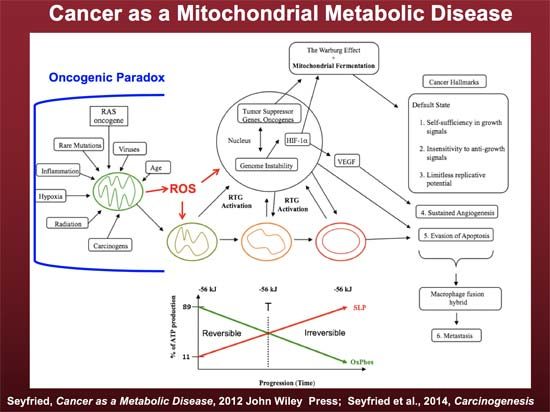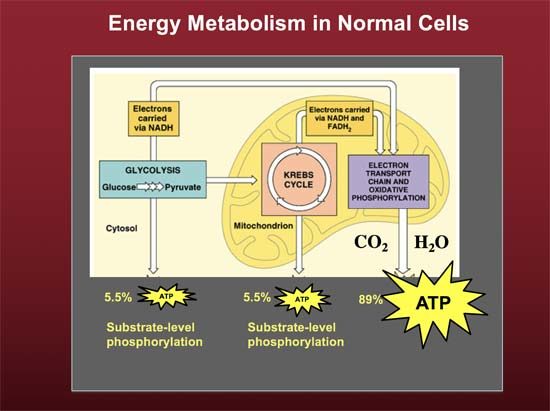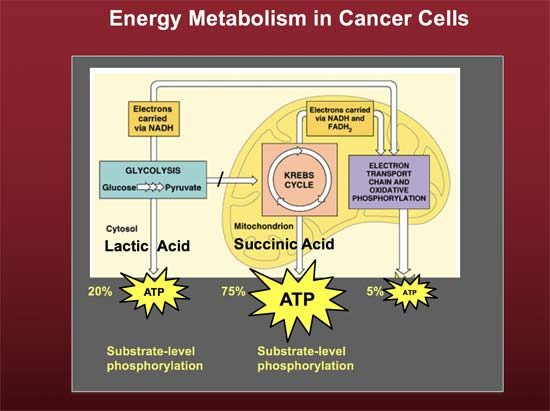The actual podcast can be heard on Dr. Attia's site.
Seyfried, in my view, is simply the best cancer biologist in the world. The featured interview2 goes into great technical detail that can be challenging for some, but if you're interested in understanding the mechanics of cancer, I highly recommend taking the time to listen to it in its entirety, especially toward the end.
Without a doubt, it is one of the finest detailed discussions about why cancer cells grow and how conventional medicine has it mostly wrong when it comes to treatment, especially radiation and chemo. Without a doubt, it is one of the best interviews Seyfried has ever done. Although Attia is a Harvard trained physician with oncology training, he frequently disagrees with Seyfried, who schools him in the basics.
I have listened to the entire interview twice and learned even more the second time. Now I have a fairly good background on this topic so if you are new to it and have a loved one who needs this information you may need to listen a few times. Toward the end of the interview Seyfried gets into some very important principles in cancer treatment, such as:
- Being careful to avoid biopsies if at all possible as they are strongly related to allowing the cancer to metastasize.
- Surgical therapy can be a useful intervention but it should be delayed as long as possible while the patient is on metabolic therapy so the tumor will shrink and allow the margins to be more well defined so it can be removed more easily.
- Avoid radiation and chemotherapy at all costs as they typically impair the immune system that is ultimately responsible for resolving the tumor.
- More than 1,600 people die from cancer every DAY in the U.S., but 8,100 die from cancer every day in China, where the problem is far worse. Remember these are deaths per day, not cancer diagnosis.
- It is vital to understand that more people die from cancer treatment than the cancer itself.
The established dogma that cancer is a genetic disease currently rules everything, from the research that receives funding to the treatment you can expect from an oncologist. Indeed, this dogma is what fuels the entire cancer industry. Unfortunately, it's not leading to any significant breakthroughs in treatment, let alone prevention.
Seyfried and others have been able to advance the theory that cancer is primarily the result of defective energy metabolism in and damage to the cells' mitochondria. Simply put, genetic mutations are not the primary cause of cancer but are rather a downstream effect of the defective energy metabolism. As long as your mitochondria remain healthy and functional, your chances of developing cancer are actually slim.
According to Seyfried, while it's still poorly understood how a ketogenic diet works to subdue epileptic seizures, the mechanism of action on cancer cells is really clear, and is based on the pioneering findings of Dr. Otto Warburg, a classically trained biochemist who in 1931 received the Nobel Prize in Physiology or Medicine for his discovery of the nature and mode of action of the respiratory enzyme cytochrome C oxidase.3
Warburg's work shows how cells obtain energy from respiration, and how cancer cells have a fundamentally different energy metabolism compared to healthy cells (see section on Warburg Effect below).
Following in Warburg's footsteps, research by Seyfried and others show that cancer is primarily a metabolic disease involving disturbances in energy production through respiration and fermentation in the cells. Studies have actually shown that cancer is suppressed when the nucleus from a tumor cell is transferred to cytoplasm of normal cells with normal mitochondria.
What this tells us is that normal mitochondria suppress cancer growth, and in order for cancer cells to proliferate, you must have dysfunctional mitochondria.
Seyfried's research has shown that cancer growth and progression can be managed following a whole-body transition from fermentable metabolites, such as glucose and glutamine, to respiratory metabolites, primarily ketone bodies that are formed when you follow a ketogenic diet. This transition reduces tumor vascularity and inflammation while enhancing tumor cell death.
The Warburg Effect
Warburg discovered that even in the presence of oxygen, cancer cells derive energy from the ancient process of anaerobic fermentation (sometimes called glycolysis), which causes an overproduction of lactic acid. This is known as the Warburg Effect:
- Aerobically, in the mitochondria
- Anaerobically, in the cytoplasm, which generates lactic acid, a toxic byproduct in high concentrations
Cancer cells continue to produce massive amounts of lactic acid, even in a 100-percent oxygen environment, which caused Warburg to conclude that the primary cause of cancer is that the respiratory system of cancer cells is defective, causing the cells to revert from healthy aerobic energy generation to unhealthy anaerobic fermentation. You can read Warburg's 1956 paper4 "On the Origin of Cancer Cells" here.
Please note that respiratory system in this context does not refer to the lungs but rather to the processing of oxygen from the lungs in the electron transport chain of the mitochondria that ultimately passes the electrons from your food to oxygen to create water and ATP.
So, in a nutshell, what Warburg discovered is that cancer cells have dysfunctional mitochondria - hence the claim that cancer is a metabolic disease rooted in mitochondrial dysfunction.
Different Types of Mitochondrial Abnormalities Are Found in Cancer Cells
One of the primary reasons why modern researchers have failed to realize that all cancer cells have impaired respiration is because they started researching cancer using cell cultures, and when you separate the cells from the tissue and grow it in a medium, it causes them to behave in ways they normally wouldn't when in the animal or human.
Hence many researchers have claimed that cancer cell respiration is normal, when in fact it is not. According to Seyfried, during in vitro or culture research, it looks like cancer cells consume a lot of oxygen, even when producing lactic acid, which creates confusion.
He does point out that while all cancer cells have defective mitochondria, how that defect came about will vary from one cancer to another. In some cancers, there's simply a lack of mitochondria, meaning the cell does not have enough organelles to generate energy through respiration and therefore falls back on fermentation as a source of energy production.
In other cancers, the cells appear to have plenty of mitochondria, but the organelles are structurally abnormal. As noted by Seyfried, "structure dictates function," so if the structure of the mitochondria is abnormal, its function will also be abnormal. However, all cancer cells use fermentation for energy production. Seyfried has not found a single cancer with normal respiration.
In order to grow and spread, cancer cells also need ample building blocks, which Seyfried says they get from the pentose phosphate pathway, the glycolytic pathway and from glutamine. "Between glucose and glutamine, you're getting all the building blocks you need for rapid cell division," he says.
Cancer Is Not a Gene-Driven Disease
Seyfried also stresses that in his research, no genetic abnormalities were found in cancer cells at all, which firmly disputes the genetic theory which postulates that cancer is driven by genetic mutations. Sadly, Attia is still convinced that the gene theory of cancer is true. It's quite sad that such a brilliant and innovative physician fails to appreciate the depth of beauty of Seyfried's work.
Overall, an estimated 5 percent of cancers are caused by germline mutations, such as BRCA1, an inherited genetic risk factor known to raise your risk for breast cancer, or BRCA2, which raises your risk for ovarian cancer.
But as noted by Seyfried, "They're not deterministic." A certain gene mutation may raise your risk, but it's no guarantee you will actually develop the cancer in question, and it is ultimately not the true cause if you do get cancer. An exception is if the mutation damages the mitochondria's respiratory system; then cancer is a very real possibility.
Warburg's Missing Link
The featured interview also delves into the details of mitochondrial substrate level phosphorylation (mSLP) - the missing link in Warburg's cancer theory. When mitochondria are damaged, causing them to revert to such an inefficient form of energy production, how is it that they have enough energy to massively reproduce and grow?
For years, Seyfried suspected glucose fermentation wasn't the whole story, and his research shows cancer cells can in fact ferment not only glucose but also glutamine, and the majority of the energy for cancer formation actually comes from the glutamine.
Glutamine is fermented via mSLP in the tricarboxylic acid (TCA) cycle - also known as the Krebs cycle - of the mitochondria. The TCA or Krebs cycle is a series of chemical reactions catalyzed by enzymes that form a key part of aerobic respiration. Seyfried explains:
mSLP is the production of ATP when you move a phosphate group from an organic substrate onto an ADP molecule, so it's an ancient way of generating energy. In other words, it's an organic molecule that is an electron acceptor rather than oxygen ...Why Cancer Cells Don't Self-Destruct
You're moving phosphate groups from an organic substrate onto the ADP as the acceptor, and you can generate massive amounts of energy from this process which can replace the level of lost energy from the damaged mitochondria ...
In the normal cell, you're making most of your ATP from oxidative phosphorylation, but in the cancer cell you're making most of it from mSLP inside the same organelle [i.e., the mitochondria].
Another question of import is "Why don't cancer cells die through the apoptotic mechanisms?" meaning the mechanism that triggers cellular suicide when the cell is damaged or malfunctioning. In short, because the mitochondria that actually controls that self-destruct "switch" is dysfunctional.
"The cell bypasses the normal control of life and death - apoptosis of the cell - because the very organelle that dictates that is [the mitochondria], is now defective," Seyfried says. As a consequence, the cell reverts back "to the way it existed before oxygen came into the atmosphere on the planet."
Healthy Mitochondrial Respiration Prevents Cancer Formation
The take-home message here is that as long as your mitochondrial respiration remains healthy, cancer will not develop. "That goes back to prevention," Seyfried says. "How do you prevent cancer? You prevent it by keeping your mitochondria healthy."
And how do you keep your mitochondria healthy? Primarily by avoiding toxic environmental factors and implementing healthy lifestyle strategies. This is in fact the sole focus of the metabolic mitochondrial therapy program detailed in my book "Fat for Fuel." Topping my list of strategies to optimize mitochondrial health - which you can learn more about in my book - are:
Cyclical nutritional ketosis - The divergence from our ancestral diet - this massive prevalence of processed, unnatural foods and excessive amounts of added sugars, net carbs and industrial fats - is responsible for a majority of the damage to your mitochondria.
High-carb, processed food diets prevent your body from efficiently burning fat as its primary fuel, and burning fats and ketones is far more efficient, inducing far less oxidative stress, than burning carbs. So, a foundational dietary strategy to optimize your mitochondrial health is to eat the right fuel. Once you become an efficient fat burner, you minimize the oxidative stress placed on your mitochondria, which is key.
Calorie restriction - Another extremely effective strategy for reducing mitochondrial free radical production is to limit the amount of fuel you feed your body. This is a noncontroversial position as calorie restriction has consistently shown many therapeutic benefits.
Meal timing - Meal timing is also important. Specifically, eating too late in the evening, when your body doesn't need the energy, is one of the worst things you can do to your mitochondria, as it creates a buildup of ATP that is not being used.
As a result, it's not being broken down into ADP, causing ATP synthase to shut down. At that point, the entire electron transport chain backs up, causing excessive amounts of free radicals to spill out and damage the mitochondrial DNA.5
Normalizing your iron level - Iron also plays an important role in mitochondrial function, and contrary to popular belief, excessive iron levels are far more prevalent than iron deficiency. Virtually all men over the age of 16 and post-menopausal women are at risk of high iron.
Menstruating women are protected since they lose blood, and hence iron, each month. While most people damage their mitochondria by eating a high-carb, low-fat diet and/or excessive protein, elevated iron levels can cause profound mitochondrial damage as well.
When you have high iron levels in your mitochondria, it enhances oxidation, creating high levels of damaging reactive oxygen species and free radicals. Fortunately, high iron is easy to address. Simply check your iron level with a serum ferritin test, and if your level is high, donate blood two or three times a year to maintain a healthy level.
An ideal iron ferritin level is between 40 to 60 nanograms per milliliter (ng/mL). Below 20 ng/mL is a deficiency state, and you definitely do not want to be above 60 or 80 ng/mL.
An important side note to this is that excess carbohydrates in particular, when eaten late at night, result in a backup of electrons, causing the production of superoxide. While not a pernicious free radical in and of itself, if you have high iron levels combined with high superoxide, it produces hydroxyl free radicals, which is one of the most harmful.
The chemical reaction that creates these hydroxyl free radicals is known as the Fenton reaction. While you certainly need enough iron, having too high an iron level can cause severe damage, and this is one way in which it does that.
Exercise - Exercise upregulates PGC-1 alpha and Nrf2 - genes that promote mitochondrial efficiency, helping them grow and divide so that you actually have more mitochondria.
In simple terms, by placing an increased energy demand on your cells through physical activity, free radicals signal that you need more mitochondria to meet the energy demand. As a result, your body adapts to your level of activity by creating more mitochondria and making them work more efficiently.
Interestingly, in his book "Mitochondria and the Future of Medicine," Dr. Lee Know, a naturopathic physician, explains how some people need more exercise to maintain mitochondrial health.6 When hydrogen ions flow back through ATP synthase, energy is created. But in some cases, and in certain tissues, such as in brown adipose tissue, this process can become uncoupled.
Instead of the hydrogen ions flowing back through ATP synthase, they flow through a different channel, creating heat rather than energy. A benefit of this is that it allows the electron transport chain to continue to operate even though you're not using up energy. The hydrogen gradient is being dissipated through the generation of heat instead.
If your genetic heritage stems from equatorial regions and/or if you have very dark skin, you will tend to have less brown fat, and hence less mitochondrial uncoupling, which raises your risk of chronic disease. To counteract this, you will need to exercise regularly. Also, be mindful of your vitamin D level, and consider cold thermogenesis (cryotherapy) to build brown and beige adipose tissue.
Nutritional supplements - The following nutrients and cofactors are also needed for mitochondrial enzymes to function properly:
- CoQ10 or ubiquinol (the reduced form)
- L-Carnitine, which shuttles fatty acids to the mitochondria
- D-ribose, which is raw material for the ATP molecule
- Magnesium
- Marine-based omega-3
- All B vitamins, including riboflavin, thiamine and B6
- Alpha-lipoic acid (ALA)
Seyfried is not alone in his strong belief in the metabolic origins of cancer. Dr. Abdul Slocum, a physician from Turkey, is already using this information in his clinical practice, where he treats many end-stage cancer patients. A significant number of his patients have pancreatic cancer, which has one of the worst prognoses of any cancer.
Over 90 percent of pancreatic cancer patients die within five years. When they enter his clinic, patients are immediately placed on a ketogenic diet and remain on it throughout their treatment.
Remarkably, Slocum is able to save many of these "hopeless" patients. What's more, his treatment protocols are nontoxic. By harnessing your body's ability to fight the tumor naturally, through the implementation of nutritional ketosis and other strategies, any chemotherapy agents used can be applied in the lowest possible dose. Slocum's practice reveals the very real benefits of treating cancer as a metabolic disease.
Support Cutting Edge Metabolic Therapies That Address the True Cause of Cancer: Defective Mitochondria
Seyfried is conducting preclinical research at Boston College, exploring a cocktail of metabolic therapies in a metastatic mouse model, including the combination of:
- Ketogenic diet
- Glycolytic inhibitors
- Oxygen therapy
- Glutamine inhibitors
- Exogenous ketones
- Other metabolic targeting therapies
To further this project, Travis Christofferson founded the nonprofit Foundation for Metabolic Cancer Therapies (formerly Single Cause Single Cure Foundation8). I encourage you to make a donation to this incredible research project, as the possibilities of it actually saving lives are far greater than most other cancer organizations, which exist solely to support the slash, poison and burn paradigm.
I am working with Christofferson to have Seyfried's metabolic therapies available for use as a primary intervention in a few cancer clinics and will have that information posted when they are available.
Importantly, while other organizations will take a large percentage of your donations for administrative expenses, 100 percent of donations to Foundation for Metabolic Cancer Therapies will go to fund Seyfried's research. You can make a tax-deductible donation online or by mailing in a check:
- Send a check of any amount made out to and mailed to The Foundation for Metabolic Cancer Therapies, 3213 West Main Street #256, Rapid City, SD 57702
- Donate online at Foundation for Metabolic Cancer Therapies. You can make a one-time donation or set up recurring contributions.
- 1 Cancer as a Metabolic Disease: On the Origin, Management, and Prevention of Cancer by Thomas Seyfried
- 2 peterattiamd.com
- 3 Nobel Prize Facts, Otto Warburg
- 4 Science February 24, 1956; 123(3191): 309-314 (PDF)
- 5 Journal of Aging Research 2011 Article ID 807108
- 6 Mercola.com, What You Really Need to Know About Your Mitochondria
- 7 Nutrition & Metabolism 2017; 14: 19
- 8 Foundation for Metabolic Cancer Therapies







Comment: See also: